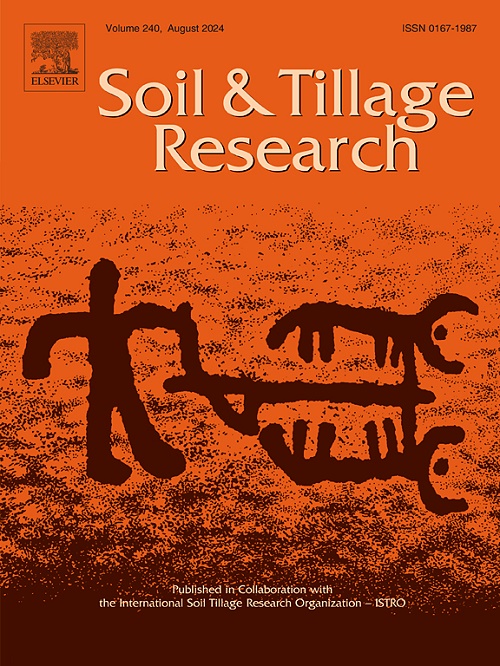Predicting soil erosion rates of farmland with different slope shapes in Northeast China by using the improved RUSLE2 model
IF 6.1
1区 农林科学
Q1 SOIL SCIENCE
引用次数: 0
Abstract
The Revised Universal Soil Loss Equation, Version 2 (RUSLE2) is widely used for regional soil erosion estimation. However, its performance on croplands in the Mollisol region of Northeast China remains insufficiently quantified, particularly for areas characterized by long and gentle (> 100 m and < 10°) and with different slope shapes (convex, straight, concave). This study integrated ¹ ³⁷Cs tracing technique to identify systematic underestimation errors in RUSLE2 predictions, primarily caused by oversimplified linear assumptions in conventional slope length factor (λ) calculations. To address this limitation, this study employed Random Forest Regression (RFR) to model non-linear λ- relationships, where represents the slope shape weight factor. The results revealed that the distribution of predicted and measured erosion-deposition rates across different slope shapes exhibited a clear alternating pattern of strong and weak values. Furthermore, the fluctuations in the predicted values were aligned with alterations in the slope gradient. Both predicted and measured mean erosion rates on different slopes were in the order that convex > straight > concave. The optimized model significantly improved predictive performance, with slope length (λ) and slope shape factor () as the key factors. The model demonstrated strong adaptability, with the highest predictive accuracy achieved for concave (R² = 0.99*), followed by straight (R² = 0.88*) and convex (R² = 0.82*) slopes. This study provides theoretical support for improving soil erosion prediction models and a scientific basis for optimizing soil and water conservation strategies.
基于改进RUSLE2模型的东北不同坡型农田土壤侵蚀速率预测
修订通用土壤流失方程第2版(RUSLE2)被广泛用于区域土壤侵蚀估算。然而,其在东北Mollisol地区农田的表现仍然不够量化,特别是在长而温和的地区(>;100 m和<;10°)和不同的斜坡形状(凸、直、凹)。该研究整合了¹ ³⁷Cs示踪技术,以识别RUSLE2预测中的系统性低估误差,这主要是由传统坡长因子(λ)计算中过于简化的线性假设造成的。为了解决这一限制,本研究采用随机森林回归(RFR)来建模非线性λ-Kslope形状关系,其中Kslope形状代表斜率形状权重因子。结果表明:预测和实测侵蚀沉积速率在不同坡型上的分布呈现出明显的强弱交替格局;此外,预测值的波动与坡度的变化一致。不同斜坡的预测和实测平均侵蚀速率依次为凸形>;直形>;凹形。优化后的模型以坡长(λ)和坡形因子(Kslope shape)为关键因子,显著提高了预测效果。该模型具有较强的适应性,对凹坡(R²= 0.99*)的预测精度最高,其次是直坡(R²= 0.88*)和凸坡(R²= 0.82*)。该研究为完善水土流失预测模型提供了理论支持,为优化水土保持策略提供了科学依据。
本文章由计算机程序翻译,如有差异,请以英文原文为准。
求助全文
约1分钟内获得全文
求助全文
来源期刊

Soil & Tillage Research
农林科学-土壤科学
CiteScore
13.00
自引率
6.20%
发文量
266
审稿时长
5 months
期刊介绍:
Soil & Tillage Research examines the physical, chemical and biological changes in the soil caused by tillage and field traffic. Manuscripts will be considered on aspects of soil science, physics, technology, mechanization and applied engineering for a sustainable balance among productivity, environmental quality and profitability. The following are examples of suitable topics within the scope of the journal of Soil and Tillage Research:
The agricultural and biosystems engineering associated with tillage (including no-tillage, reduced-tillage and direct drilling), irrigation and drainage, crops and crop rotations, fertilization, rehabilitation of mine spoils and processes used to modify soils. Soil change effects on establishment and yield of crops, growth of plants and roots, structure and erosion of soil, cycling of carbon and nutrients, greenhouse gas emissions, leaching, runoff and other processes that affect environmental quality. Characterization or modeling of tillage and field traffic responses, soil, climate, or topographic effects, soil deformation processes, tillage tools, traction devices, energy requirements, economics, surface and subsurface water quality effects, tillage effects on weed, pest and disease control, and their interactions.
 求助内容:
求助内容: 应助结果提醒方式:
应助结果提醒方式:


